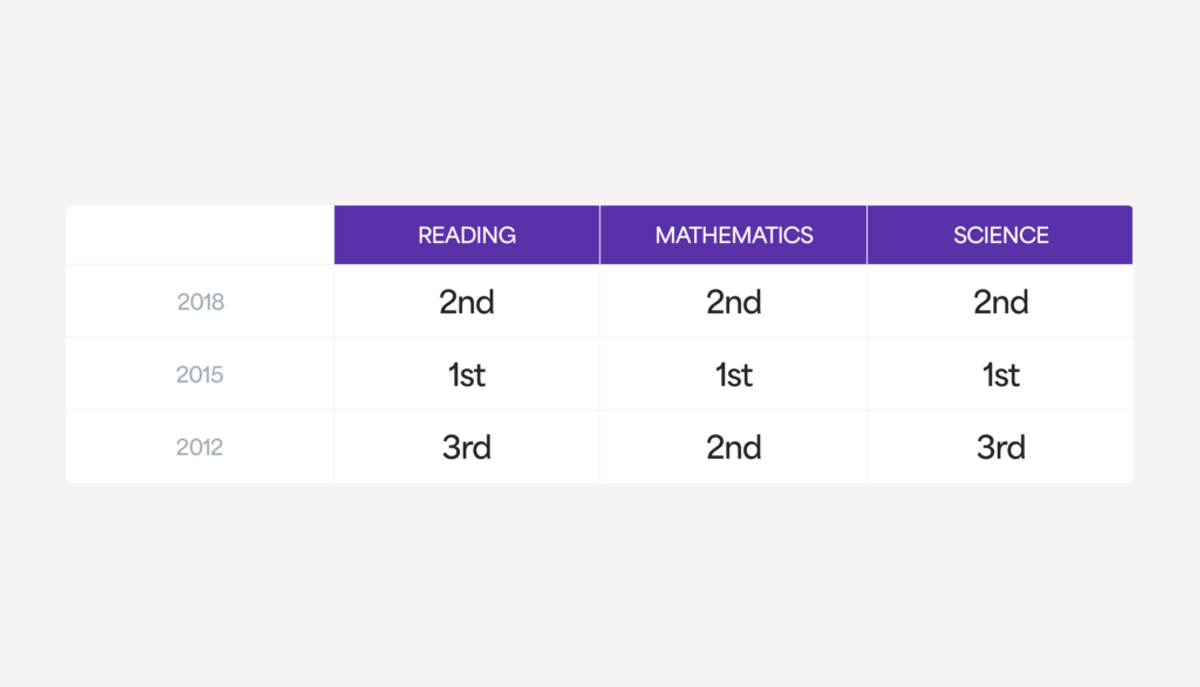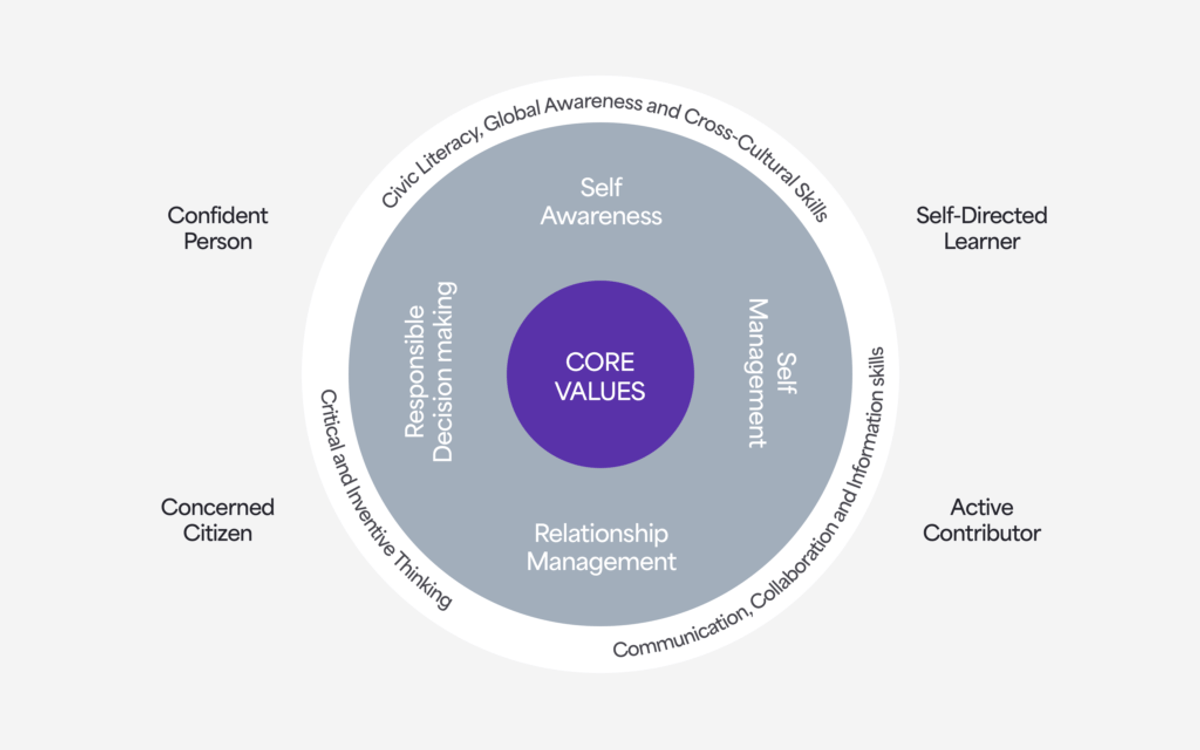A tiny Asian island state of just 728 square kilometres with 5.7m inhabitants cannot be ignored when discussing educational transformation and the role of assessment.
Singapore is an educational super-power. Near the top of all international comparisons, 97% of students continue in education after 18.
This has been achieved through a structured, centralised approach, a prescribed national curriculum and relatively uniform classroom teaching and practice. Traditionally Singapore has emphasised rote learning, memorisation, and hard work with high stakes examination success the goal.
Singapore's PISA Rankings Over Time

Source: OECD
A highly educated population has been the result but with the corollaries of grade obsession and competitive stress for students and parents.
But Singapore’s education system is changing significantly as it seeks to prepare students for the more complex demands of the 21st century.
In our country briefing, AQi examines in depth the Singaporean approach, how it is changing and what we might learn.
The Singapore Story
When Singapore became independent in 1965 it was a relatively poor nation with GDP per head like Mozambique or Pakistan. Literacy rates were low. Secondary education was limited to the privileged.
Today Singapore’s GDP per head is twice that of the UK. The city state has fast-growing banking, technology and digital economies and the World Bank ranks Singapore top in its human capital index.
Human Capital is essential to Singapore. The nation has been determined to create competitive advantage through the educational development of its population.
Lee Kuan Yew, Singapore’s ‘founding father’ and Prime Minister from 1959 until 1990 emphasised educational progress as key to the country’s development.

Lee Kuan Yew
Our priority must be to develop Singapore’s only natural resource, its people.
Lee Kuan Yew
Education strategy has evolved in lockstep with the development of the Singaporean nation and its economy. It has reflected the nation’s needs, aspirations, and emerging global position.
Highly Structured Foundations
Early focus was on the creation of neighbourhood schools to provide sufficient places, embedding a tightly specified curriculum, recruiting more, better teachers and closely controlling standards. The explicit aim was to improve the education of all children and elevate educational outcomes.
Assessment structures were embedded into the system with high stakes exams at the end of primary and secondary streaming students. Formative testing was added early with teachers well-trained in its application. This raised student achievement levels in exams even if the impact on levels of understanding is less certain.
Teaching practices have been carefully guided across subjects and levels. The approach has been pragmatic, using both Eastern and Western teaching techniques, testing their impact and applying them to maximise outcomes as measured by tests and exams. More power has been delegated to schools as the quality of teachers has increased.
In class, teaching techniques are changing but textbooks, worksheets, drill and practice remain important and the emphasis on exams means that teachers must cover the curriculum and often ‘teach to the test’.
These process-driven approaches gave the Ministry of Education the levers to push achievement levels upwards. The Ministry’s central role and strong implementation mean that curriculum, teaching and assessment have been developed together and remained closely aligned.
Another enduring priority has been recruiting and training high quality teachers, building the capacity and flexibility of the system. Supported by 50 years of effort, building the profile of education and the teaching profession, teachers have high status in Singaporean society. High performing teachers are promoted without particular emphasis on tenure.
Teachers, parents and educationalists have been supportive of the government’s approach. The distinctive Singaporean experience means that education has steadily become of more central importance in society.
A Strategy of Continuous Evolution
Singaporean educational policy and practice have continuously evolved without dramatic reform.
The Ministry of Education takes the long-view, spots trends early and is good at implementing evolutionary change. ICT and cross-curricular skills were introduced early. New pedagogical concepts and teaching practices from home and abroad have been developed, tested, and adopted if found to be positive in their impact. Teaching practices have been evolved to encourage independent learning and develop critical thinking.
Across schools there is a move from control to empowerment. Classroom innovation has become an integral part of the professional development of Singaporean teachers. Schools and teachers are being given greater autonomy, supported by new forms of professional development, mentoring, and the sharing of ideas between schools at the local level.
Since 2010 the focus has taken significant steps towards building new competencies and applied learning into education.
Singapore clearly believes the educational model that has been successful needs to change to prepare students for the very different demands of the globalised, digitised, 21st century knowledge economy where Singapore aims to succeed in the highest value sectors.
The curriculum has been slimmed, testing reduced, particularly in the younger years, and there is more focus on competencies and softer skills such as creativity, problem solving, decision making and communication.
Singapore's Framework of 21st Century Competencies and Student Outcomes

This change of focus is felt tangibly through the introduction of Applied Learning Programmes in primary, which have been spread throughout the school system.
Vocational learning has also been transformed. Vocational routes that were considered second-rate a generation ago are now attractive and respected with strong, up-to-date curricula, high quality teaching in modern, cutting-edge facilities and clear pathways to high value employment.

Institute of Technical Education Central - one of Singapore's 3 main locations for vocational education
The direction of travel is clear. Singaporean policy makers have decided that the traditional focus on core subjects, and use of rote learning, heavy curricula and assessment are not well-suited for the 21st century. So they are evolving the system piece by piece.
Themes and Conclusions
Like all nations, Singapore’s educational system is a product of its unique history and experience.
But are there themes we can learn from?
- The clarity and continuity of Singapore’s vision for education has been central to success. The evolving vision has won general support from teachers, educationalists, and parents. Through clear communication the population’s commitment to education has been grown over 50 years.
- Educational strategy has been implemented with careful coordination of three pillars: curriculum, teaching and assessment have evolved together and remained closely aligned.
- The strength and depth of the teaching and school management cadre has been built through improving recruitment, training and development. The balance of power and decision-making has been delegated, creating a more robust and flexible system.
- Singaporean students may be over-assessed in the eyes of many commentators but Singapore’s teachers are well-trained in assessment and use it positively as a formative tool to focus student support and interventions. This helps prevent students being left behind.
- In recent decades vocational education has received focus and investment to become a respected route to high value employment. This has drawn more young Singaporeans into further and higher education.
- Educational policy continuously evolves from evidence, research and long-term planning linked to wider political and economic priorities.
Singapore’s traditional teaching practices, tight curriculum, focus on assessment and exam achievement have achieved exceptional results by international standards.
Now the focus is evolving to include far greater focus on skills, competencies and many of the themes that the OECD and educational thinkers believe will be critical in the 21st century.
Given Singapore’s history of educational foresight, it would be foolish to ignore their direction of travel.
For more depth about Singapore, visit our Singapore briefing.
READ MORE INTERNATIONAL PERSPECTIVES:
Singapore: Global education pace setter looks for another gear
Estonia - a small country with big results
Massachusetts: The power of public education data
Finland: Going against the global trend









